Vision and Creativity
by Michael Frye | Sep 20, 2022 | Light and Weather, Vision and Creativity
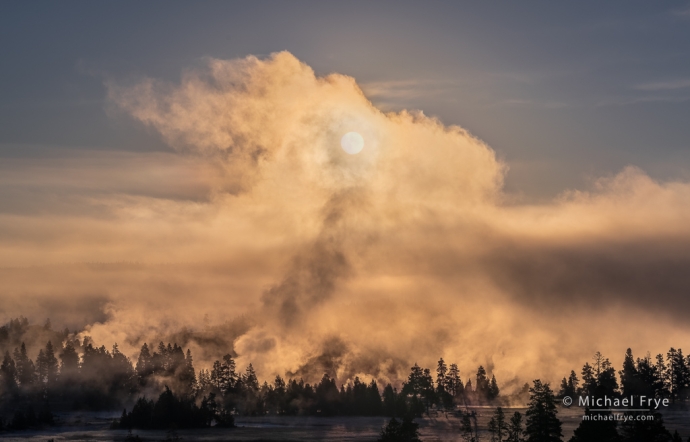
Sun rising through fog and steam, Yellowstone NP, Wyoming. Standing on a low hill, I moved to position the sun behind the column of steam, in order to avoid lens flare and prevent the sun itself from being completely blown out. With this extreme constrast I bracketed five frames, two stops apart, and blended the exposures with Lightroom’s HDR Merge. 100mm, bracketed shutter speeds, f/11, ISO 100.
If you read this blog regularly you know that I love fog and mist. And few places generate fog and mist as consistently as the thermal areas of Yellowstone during cold weather. Warm, moist air rising from the geysers and hot springs into the colder surrounding atmosphere creates a perfect recipe for mist formation.
During the first part of our stay in Yellowstone the daytime highs were in the low to mid 80s. But the daily temperature fluctuations were tremendous, so the next morning the thermal areas would be near freezing – a difference of around 50 degrees Fahrenheit (or about 28 degrees Celsius). So despite unusually warm days for early September, we still found plenty of steam and fog in the mornings. And toward the end of our stay a cold front came through, temps dropped, and we saw even more mist.
(more…)
by Michael Frye | May 11, 2022 | Travels and Stories, Vision and Creativity
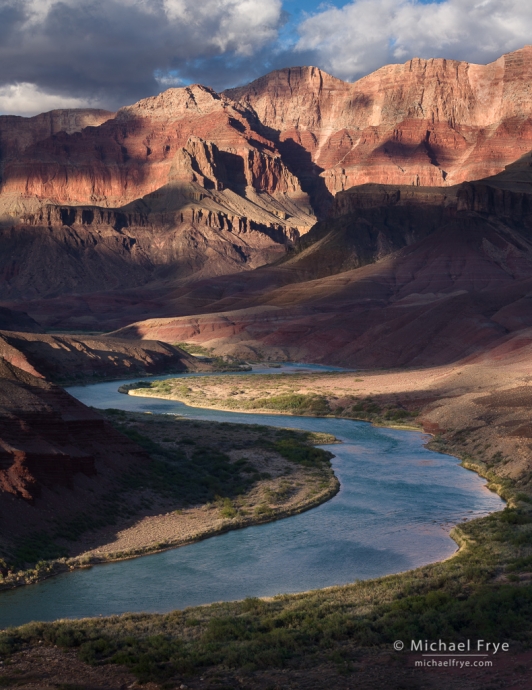
Dappled light along the Colorado River, Grand Canyon National Park. Watching the cloud shadows move across the canyon from this spot was one of the highlights of the trip for me.
Most people make their best photographs of places or subjects they’re familiar with.
In landscape photography, it helps immensely if you know an area well, and know what spots might work best under certain conditions, so you can put yourself in the right place at the right time.
I think it’s also natural and inevitable that we’re going to make our best and most meaningful images when we feel a connection with the subject or place. You can often trace a direct correlation between the depth of that connection and the depth of the imagery. And making those connections takes time.
(more…)
by Michael Frye | Feb 17, 2022 | Advanced Techniques, Vision and Creativity
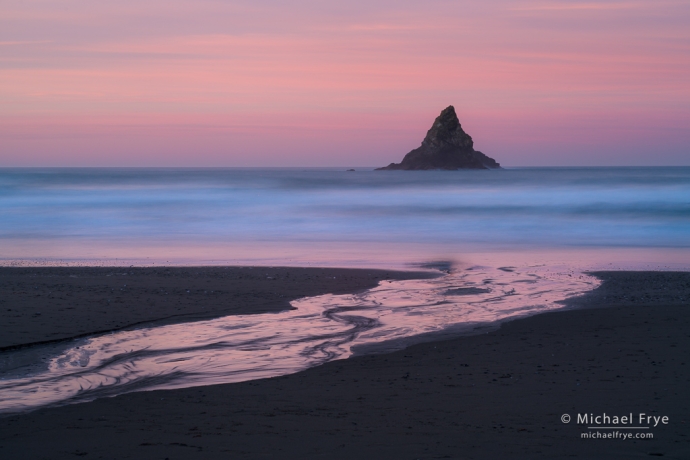
Creek and sea stack, sunrise, Oregon Coast. I used a slow shutter speed (30 seconds) to smooth the waves, which simplified the scene by eliminating texture in the water, and helped create a more ethereal quality to the image.
In one of my posts about Yellowstone last fall I talked about my attraction to dynamic landscapes. And Yellowstone is certainly dynamic, with its ever-changing array of spouting geysers and steaming vents.
But seascapes might be even more dynamic. In addition to the usual variables of landscape photography – light and weather – there’s the ocean itself. Tides, wave height, wave direction, and wind all have big effects on the way a scene looks. And no two waves are the same, so one moment will often look quite different from the next.
(more…)
by Michael Frye | Apr 20, 2021 | Digital Darkroom, Vision and Creativity
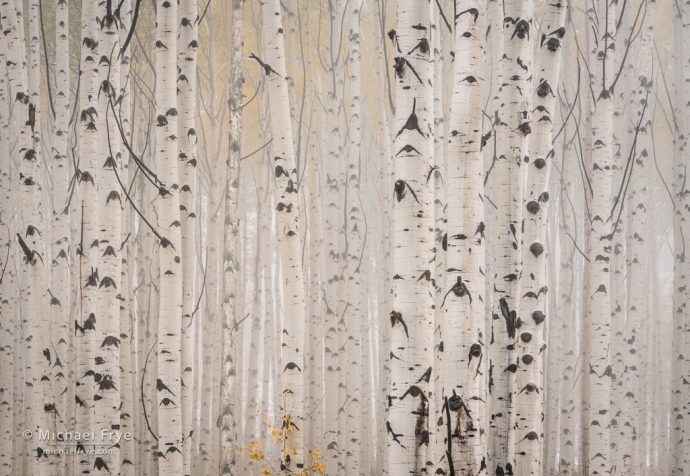
Aspens in fog, White River NF, Colorado. I used a bit of negative Dehaze to slightly soften this image.
In preparing my recent presentation for the Out of Chicago Live conference, I was digging through my archives for examples to use, and found some interesting images I had overlooked. In some cases I had put them aside, too busy to process them at the time, and then just forgot about them. In other cases I think my perceptions had changed. And sometimes I could see the potential to process an image differently, using new tools and new skills.
One of those tools is the Dehaze slider in Lightroom. It’s not that new (2015), but didn’t exist when I initially processed some images, and can sometimes make a big difference – especially with fog. I’m a big fan of fog for forest scenes, and these days I’m often using Dehaze selectively with the Adjustment Brush to cut through fog in one part of an image, or thicken fog in another area to hide or deemphasize something. (Just to be clear, you can’t create fog where none existed; there has to be some fog to begin with. But you can make some tenuous fog look a little more substantial. I show how to do all this in my latest Lightroom course, Landscapes in Lightroom: Advanced Techniques.)
(more…)
by Michael Frye | Nov 22, 2020 | Travels and Stories, Vision and Creativity
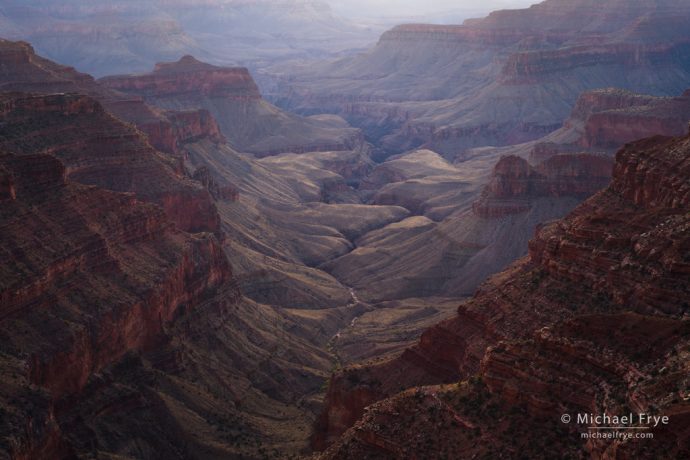
Dusk light, Grand Canyon, Arizona
In a recent post I described how Claudia and I made a spur-of-the-moment detour to the North Rim of the Grand Canyon. We arrived in the afternoon, and spent the rest of the day checking out various viewpoints.
As sunset approached we had just enough light to check out one more spot. We made it there just after sunset, and in the gathering dusk I thought the light in the canyon to the west was exquisite: soft, with a beautiful backlit glow, and a slight haze to add atmosphere and depth.
(more…)
by Michael Frye | May 10, 2020 | Vision and Creativity
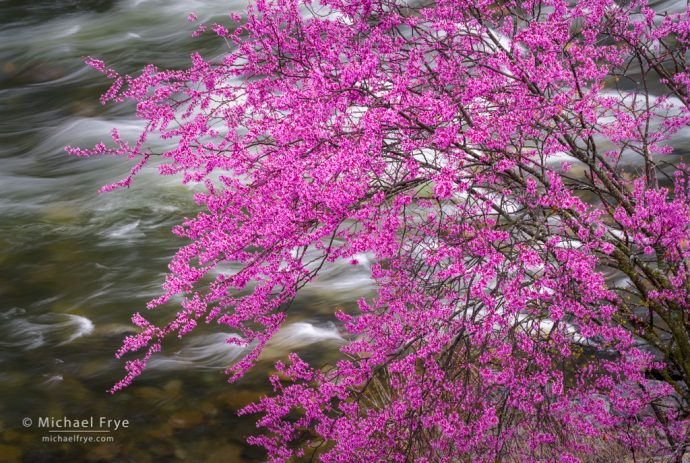
Redbud above a rapid in the Merced River, California
My mother grew up in the Panama Canal Zone, in the hills above Panama City, running and playing all year in the tropical weather, watching sloths in the trees outside her bedroom window, shaking her shoes out each morning to make sure there were no scorpions inside.
When she was 13 years old her family moved to Queens, New York, but later, in the early years of her marriage, she and my father migrated to the outer suburbs, and once again she was surrounded by nature. She would often point out beautiful things she noticed to my brothers and me: the first buds of spring, a sunset, ice-coated branches, a bird singing, autumn leaves starting to turn…
(more…)














